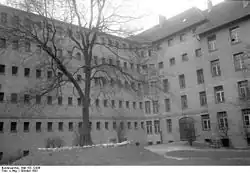 Barnimstrasse women's prison in 1931 | |
| Location | Friedrichshain, Berlin |
|---|---|
| Coordinates | 52°31′29″N 13°25′32″E / 52.5248°N 13.4255°E |
| Status | Closed |
| Security class | Womens Prison |
| Capacity | 357 |
| Population | 500 (as of end of World War II) |
| Opened | May 1868 |
| Closed | 1974 |
| City | Berlin |
| State/province | Brandenburg |
| Country | Germany |
Barnimstrasse women's prison was a women's prison that existed between 1868 and 1974 in Barnimstraße in the Friedrichshain district of Berlin, which belonged first to the Königsstadt and from 1920 to the Friedrichshain district.[1]
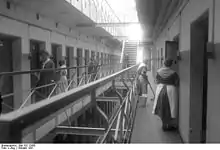
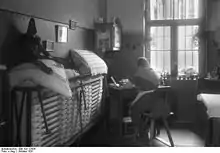

Building history
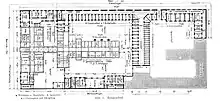
In 1864, a new debtors' prison was built in Berlin's royal city, north-east of today's Alexanderplatz, under the direction of architects Carl Johann Christian Zimmermann and Albert Cremer. After Prussia abolished imprisonment for debtors in May 1868,[2] it was converted and extended to become the Royal Prussian Women's Prison.
In the spring of 1910, the prison was expanded with some reconstruction of the internal structure that was completed by November 1913.[3] A maternity ward and a mother-and-child ward were also built. It was the most modern prison in the city and offered space for 357 inmates, and could even be increased to 500. There was now a military hospital with 38 beds for sick prisoners. In addition, the architects added a three-storey building to the service yard, which housed the kitchen and other service units such as the laundry, bathing facilities and a steam boiler.[3][4]
The buildings survived the bombing raids and hostilities at the end of the World War II with only minor damage. However, due to the work opportunities in a neighboring industrial laundry, a new women's prison was built in Köpenick in 1974.[1] The buildings on Barnimstrasse were subsequently demolished.[1] The site was initially used as a sports ground with a gymnasium, concrete floor and jumping pit, and in the 1990s a traffic education facility was established.
Detention
Monarchy and Weimar Republic
During the monarchy, the prison was primarily occupied by petty criminals, including many prostitutes which were in the majority by 1933.[1] The number of new inmates who were prostitutes began to decline in 1927 due to the "Reich Law to Combat sexually transmitted diseases" (Reichsgesetz zur Bekämpfung der Geschlechtskrankheiten) being introduced that made prostitution exempt under certain conditions.[1] Up until 1926, abortion was punishable by up to 10 years in prison.[1] As a result of the socialist laws and the anti-war movement of World War I, women were also imprisoned for political reasons.[1] The German Marxist and anti-war activist Rosa Luxemburg was imprisoned in Barnimstrasse in 1907[5] and 1915-1916 for giving an anti-war speech.[6]
Inside the prison buildings, it was compulsory to wear institutional clothing, which consisted of a clean blue wash dress with a white and blue neckerchief and blue knitted wool stockings with a red stripe. For cooler days there was a blue jacket with the old sleeve cut. The women responsible for preparing food had to cover their hair with a white cloth.[4]
Anyone who was sentenced to more than six months in prison was placed in a three-tier system, the different levels of which gave the prisoners some advantages over the other women, including that the lights were allowed to stay on longer in the cell and a second book from the prison library was also allowed per week. With good behavior, prisoners could work their way up.[4] Particular consideration was given to imprisoned mothers with children: they lived with their children in a mother's cell that contained toys and flowers were also allowed to be placed here. A doctor came once a day to check on everything.[4]
National Socialism
During the period of Nazism, the prison served as a Gestapo remand prison and as a stopover between the Plötzensee Prison execution site and other prisons and camps. Pregnant women gave birth here before being executed. Hans Coppi Jr. and Anita Leocádia Prestes, for example, were born here. Over 300 women of the resistance started their final journey from here, including:[7]
A–D Judith Auer Marianne Baum Lina Beckmann Olga Benario-Prestes Liane Berkowitz Cato Bontjes van Beek Erika von Brockdorff Eva-Maria Buch Hilde Coppi E–H Anna Ebermann Charlotte Eisenblätter Katharina Fellendorf Ursula Goetze Helene Gotthold Auguste Haase Liselotte Herrmann Frieda Horstbrink I–P Else Imme Hildegard Jadamowitz Wanda Kallenbach Johanna Kirchner Helene Knothe Sala Kochmann Annie Krauss Ingeborg Kummerow Vera Obolensky Q–T Galina Romanova Klara Schabbel Pelagia Scheffczyk Rose Schlösinger Elfriede Scholz Oda Schottmüller Maria Terwiel Elisabeth von Thadden Käthe Tucholla Elfriede Tygör U–Z Käte Voelkner Elli Voigt Frida Wesolek Irene Wosikowski Emma Zehden
They include women from well-known resistance groups and movements:
- The resistance groups of the Red Orchestra included: Käte Voelkner, Frida Wesolek, Käthe Tucholla, Maria Terwiel, Rose Schlösinger, Oda Schottmüller, Klara Schabbel, Annie Krauss, Ingeborg Kummerow, Krystana Iwanowa Janewa, Katharina Fellendorf, Else Imme, Ursula Goetze, Cato Bontjes van Beek, Erika von Brockdorff, Eva-Maria Buch, as well as Hilde Coppi and Liane Berkowitz, who were both pregnant at the time of their arrest.
- The Berlin workers' resistance included: Judith Auer, Marianne Baum, Gerda Boenke, Anna Ebermann, Charlotte Eisenblätter, Charlotte Garske, Auguste Haase, Elli Hatschek, Hella Hirsch, Hildegard Jadamowitz, Marianne Joachim, Sala Kochmann, Krista Lavíčková, Hildegard Loewy, Hildegard Margis, Hanni Meyer, Galina Romanova, Elfriede Tygör, Elli Voigt, Irene Walter, Suzanne Wesse and others
- In connection with the assassination attempt on Hitler known as the 20 July plot: Elisabeth Charlotte Gloeden and her mother Elisabeth Kuznitzky
- Members of the Resistance: Johanna Kirchner,[1] Vera Obolensky, Ruth Oesterreich, Irene Wosikowski
- The underground Jehovah's Witnesses (Zeugen Jehovas) included: Helene Gotthold, Klara Stoffels, Auguste Hetkamp
- In connection with the Polish intelligence department "Stragan": Pelagia Scheffczyk, Gertruda Świerczek
Post war period
In the post-war years, black market transactions and theft of food or other everyday items or for example theft of ration cards were the most common reasons for imprisonment.[1] by 1947, the prison become so overcrowded to an extent that more than two-thirds of the prisoners had to sleep on the floor. Due to rationing in Germany, basic necessities like soap were extremely limited.[1]
When Berlin was split into different administrative zones, the prison administration was reorganised to fit the new reality.[1] From 1949 staff who lived in the British and America sectors were no longer allowed to visit Barnimstrasse, while prisoners from those secors who would have formerly have been jailed there, were now sent to Lehrterstrasse Prison.[1] Due to a lack of mens prison capacity in the Soviet administrative zone, Barnimstrasse had to accommodate male prisoners.[1]
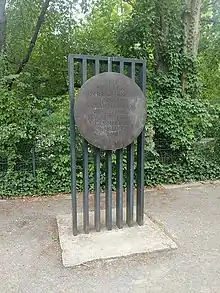
In January 1951, the Volkspolizei became responsible for the penal system in East Germany[8][1] which resulted in any penal reform attempts in the previous years coming to an end.[1]
Memorials
A memorial cell for Rosa Luxemburg was set up in the prison as early as 1950. After the buildings were demolished, a small memorial was erected in front of a neighboring school in Weinstraße in 1977.[9][10][11] A plaque on the stele, reminiscent of prison bars, reads:
- "Here stood the women's prison where Rosa Luxemburg was imprisoned for her revolutionary beliefs."
The resistance fighters were not commemorated at this point during the GDR era. Therefore, a temporary memorial plaque was installed in March 1994, the text of which read:[12]
- "Many resistance fighters against National Socialism were imprisoned in the Barnimstrasse women's prison between 1933 and 1945. For more than three hundred women, this was the last stop before their execution in Plötzensee. They were murdered because they distributed leaflets, helped those being persecuted, listened to foreign broadcasters, expressed doubts about the “final victory” or committed minor crimes for which the Nazi judiciary sentenced them to death as “public pests”. The building continued to be used as a women’s prison after 1945 and was demolished in 1974."
After this plaque was vandalized, another memorial plaque was unveiled in 1996 with the following text:[13]
- "The Barnimstrasse women's prison stood on this site until 1974. Between 1933 and 1945, it was the last stop for more than 300 female resistance fighters against National Socialism before their execution in Plötzensee."
Several resolutions were passed by the responsible district administrations, the first in 1993, to redesign the memorial, but these have not yet been implemented. However, an art competition was announced in 2007, which was decided on in April 2008. The winner of the competition was Christoph Meyer with an "audio path through a prison for women and 5 political systems".
The audio path was opened on 30 May 2015.
References
- 1 2 3 4 5 6 7 8 9 10 11 12 13 14 15 Singer, Paul; Wesner, Marina; Strube, Dorothea (2007). "Das Frauengefängnis in der Barnimstrasse" (PDF). Friedrichshain-Kreuzberg Museum (in German). Friedrichshain, Berlin. Retrieved 12 December 2023.
- ↑ Zweigert, K.; Drobnig, U. (1 March 1982). International Encyclopedia of Comparative Law, Instalment 16. Martinus Nijhoff Publishers. p. 60. ISBN 978-90-247-3011-7.
Reference 727
- 1 2 "Erweiterung und Umbau: Frauengefängnis in der Barnimstraße". Zentralblatt der Bauverwaltung (in German). Berlin (64): 469. 1914.
- 1 2 3 4 Ziegel 1929.
- ↑ Girod, Regina (2000). Nachbarn: Juden in Friedrichshain (in German). Berlin: Mondial. p. 25. ISBN 978-3-9805763-6-9.
- ↑ Frölich, Paul (1994). Rosa Luxemburg: Ideas in Action (5th ed.). London: Pluto Press. p. 170. ISBN 978-0-902818-19-4.
- ↑ Wesner, Marina; Strube, Dorothea; Wesner, Marina. "Liste der 1933–1945 in der Barnimstraße inhaftierten Frauen, die hingerichtet wurden". Ausstellung des Vereins zur Erforschung der Geschichte Kreuzbergs (in German). Mitteln des Lokalen Aktionsplan Friedrichshain-Kreuzberg im Rahmen des Bundesprogramms "VIELFALT TUT GUT. Jugend für Vielfalt, Toleranz und Demokratie". Archived from the original on 5 May 2015.
- ↑ "The East German Peoples Police". Military Review. XXXII (4): 106. July 1952.
- ↑ Eickenjäger, Karl-Georg (1979). Berlin-Friedrichshain : Baudenkmale, Gedenkstätten, Plastiken im Stadtbezirk Berlin-Friedrichshain : Baudenkmale, Gedenkstätten, Plastiken im Stadtbezirk (in German). Berlin: Plastiken im Stadtbezirk. p. 67.
- ↑ Trost, Heinrich; Büttner, Horst (1987). The architectural and art monuments in the GDR, capital Berlin I (in German). Berlin: Kunst und Gesellschaft. p. 441. ISBN 9783362001380.
- ↑ Endlich, Stefanie; Wurlitzer, Bernd (1990). Skulpturen und Denkmäler in Berlin (in German). Berlin: Stapp. pp. 238–239. ISBN 9783877760345.
- ↑ "Mitgliederrundbrief Nr. 25" (PDF). Das Aktive Museum (in German). Berlin. March 1994. Retrieved 1 January 2024.
- ↑ Bröckl, Martin; Girra, Dagmar (2001). Gedächtnis Berlin: Gedenktafeln in Friedrichshain-Kreuzberg ; von Adalbertstrasse bis Yorckstrasse (in German). Berlin: Luisenstädtischer Bildungsverein. p. 238. ISBN 978-3-89542-115-0.
Bibliography
- Ziegel, Dorothea (25 April 1929). "Barnimstraße 10: Ein Besuch im Berliner Frauengefängnis" (in German). Leipzig: Brockhaus-Verlag. Deutsche Allgemeine Zeitung.
Further reading
- Gélieu, Claudia von (2014). Barnimstraße 10: das Berliner Frauengefängnis 1868 - 1974 [Barnimstrasse 10: the Berlin women's prison 1868 - 1974] (in German). Berlin: Metropol. ISBN 9783863312244.
- Gélieu, Claudia von (1994). Frauen in Haft: Gefängnis Barnimstraße; eine Justizgeschichte [Women in prison:Barnimstraße prison;a history of justice] (in German). Berlin: Elefanten-Press. ISBN 3-88520-530-0.
- Fischer (September 2012). "Charlotte Behrends und die Kartei der zum Tode verurteilten Frauen aus dem Berliner Frauengefängnis Barnimstraße" [Charlotte Behrends and the file of women sentenced to death from Berlin's Barnimstrasse women's prison] (PDF). JahrBuch für Forschungen zur Geschichte der Arbeiterbewegung (in German). Berlin: 85–104.
- Canter, Eva Raedt-De; Ernst, Helen (1935). Vrouwen-gevangenis:roman [Women's prison:novel] (in Dutch). Utrecht: Bruna.
External links
- Landesdenkmalamt Berlin Monument database Rosa Luxemburg at the former prison location
- Documentation of the association for researching and presenting the history of Kreuzberg including List of women imprisoned between 1933 and 1945 who were executed
- Video presentation about the women's prison
- A walk through the perceptual worlds of women in 5 political systems Website of the audio trail